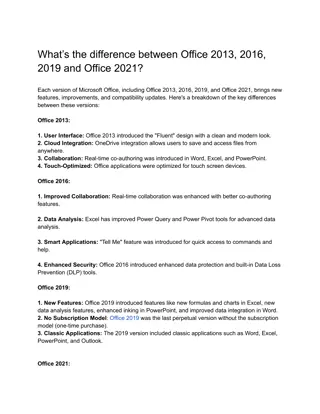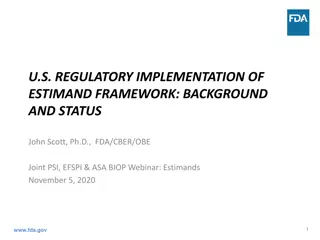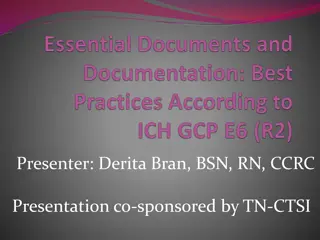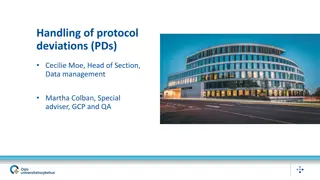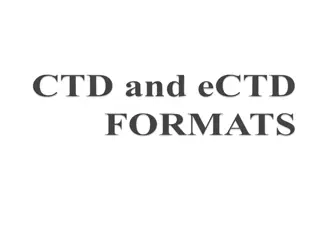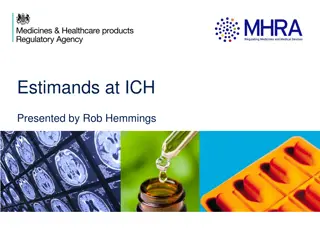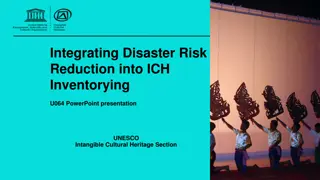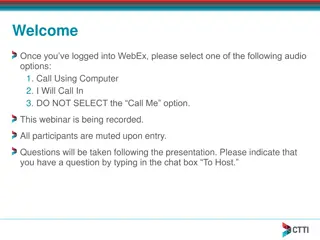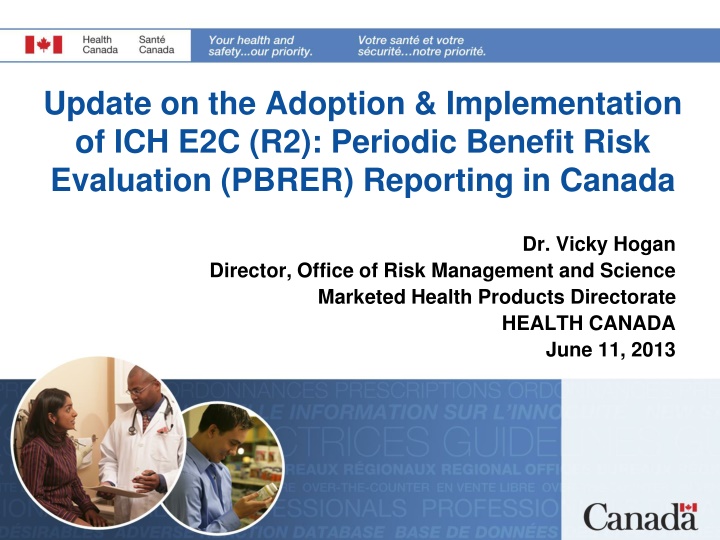
ICH E2C (R2) Implementation in Canada: PBRER Reporting Update
This update provides insights into the adoption and implementation of ICH E2C (R2) for Periodic Benefit Risk Evaluation Reporting in Canada. It covers the history of the guideline, aspects to consider in benefit-risk assessment, objectives of the revision, unchanged elements, and improvements in the reporting process.
Download Presentation

Please find below an Image/Link to download the presentation.
The content on the website is provided AS IS for your information and personal use only. It may not be sold, licensed, or shared on other websites without obtaining consent from the author. If you encounter any issues during the download, it is possible that the publisher has removed the file from their server.
You are allowed to download the files provided on this website for personal or commercial use, subject to the condition that they are used lawfully. All files are the property of their respective owners.
The content on the website is provided AS IS for your information and personal use only. It may not be sold, licensed, or shared on other websites without obtaining consent from the author.
E N D
Presentation Transcript
Update on the Adoption & Implementation of ICH E2C (R2): Periodic Benefit Risk Evaluation (PBRER) Reporting in Canada Dr. Vicky Hogan Director, Office of Risk Management and Science Marketed Health Products Directorate HEALTH CANADA June 11, 2013
Brief History of the ICH E2C Guideline 1992 CIOMS II Guideline on PSURs published 1996 Step 4 ICH E2C Guideline published 2003 Step 4 Addendum to ICH E2C (R1) published December 15, 2010 Final Concept Paper: Periodic Safety Update Reports for Marketed Drugs E2C(R2) and gap and potential improvement analysis of ICH E2C, E2E and E2F Draft Step 2 ICH Guideline Periodic Benefit Risk Evaluation Report (PBRER) E2C(R2) completed February 20, 2012 December 17, 2012 Final ICH E2C(R2) PBRER Guideline published on the ICH Website http://www.ich.org/products/guidelines/efficac y/article/efficacy-guidelines.html 2
Aspects to Consider in B-R Assessment New in the ICH E2C(R2) Uncertainty about favourable effects Favourable effects Uncertainty about unfavourable effects Unfavourable effects Addressed in ICH E2C(R1) already 3
Objectivesof the ICH E2C Revision Objective of ICH E2C(R2) Reporting: To present a comprehensive and critical analysis of the benefits and risks of a medicinal product taking into account new or emerging information in the cumulative risk-benefit analysis. Scope of ICH E2C(R2) in Canada: PBRER reporting applies to the following product lines: - pharmaceutical drugs - biological, biotechnology and blood products - vaccines (preventative and therapeutic) - radiopharmaceuticals 4
ICH E2C(R2) - What is unchanged? A single report for an active substance Use of International Birth Date (IBD) and Data Lock Point (DLP) Compatible with variable reporting frequencies according to local regulations Many of the existing data presentation sections remain; however in most cases the detailed requirements for section content have changed. Summary tabulations remain; line listings and individual case narratives no longer routinely required. 5
ICH E2C(R2) - What is improved? Strengthened focus on evaluation of available information from multiple data sources Overview of safety signals and signal/risk evaluation Improved information on patterns of use/exposure Overview of benefits and benefit evaluation Integrated benefit-risk evaluation Strengthening the link with Risk Management planning Stand alone report based on cumulative data - ease of review/assessment Supports lifecycle approach to continuous benefit-risk evaluation Modular format 6
Modular Approach Modular approach = components of various reports may be used in multiple regulatory documents. Goal is to increase consistency and decrease repetition of work, while keeping the concept of stand-alone documents, e.g., sections of PSUR/PBRER may be used in safety specifications/RMPs, Clinical Overviews, or in various versions of PBRER covering different periods of time to meet regional regulatory needs. A list of PBRER sections that may be shared with other regulatory documents is provided in Appendix D of the guideline. 7
ICH E2C(R2)- What was removed? Line listings Individual Case Safety Reports (ICSRs) Presentation of spontaneous adverse drug reactions (ADRs) in summary tabulations Classification of ADRs in summary tabulations as listed or unlisted Summary Bridging Reports Addendum Reports 8
PBRER-Overview Sections same as PSUR Additional or new requirements 1. Introduction 2.Worldwide Marketing Approval Status 3. Actions Taken in the Reporting Interval for Safety Reasons 4. Changes to Reference Safety Information 5. Estimated Exposure and Use Patterns 6. Data in Summary Tabulations 7. Summaries of Significant Safety Findings from Clinical Trials during the Reporting Interval 8. Findings from Non-Interventional Studies 9. Information from Other Clinical Trials and Sources 10. Non-Clinical Data 11. Literature 12. Other Periodic Reports 13. Lack of Efficacy in Controlled Clinical Trials 14. Late-Breaking Information 15. Overview of Signals: New, Ongoing, or Closed 16. Signal and Risk Evaluation 17. Benefit Evaluation 18. Integrated Benefit-Risk Analysis for Approved Indications 19. Conclusions and Actions 20. Appendices to the PBRER New sections 9
Scope of a PBRER Evaluation Risk evaluation shall be based on all use of the medicinal product including evaluation of safety in real world medical practice, use in unauthorised indications, and use that is not in line with the product information. If use of the medicinal product is identified where there are critical gaps in knowledge for specific safety issues or populations, such use should be reported in the PBRER (e.g., use in paediatric population or in pregnant women). Efficacy/effectiveness - the scope of the benefit information should include both clinical trial and real world data, if applicable, for all authorised indications. 10
Benefits of PBRER Reporting Provides cumulative and comprehensive information on both benefits and risk of a medicinal product Strengthens the link between risk assessment and regulatory actions taken to minimize risk Supports the life cycle approach to product vigilance Strengthens the focus on evaluation of ALL available information from multiple data sources Reduced duplication of information (modular approach) Increases accountability 11
Proportionality of Information Provided Sources of information include data regarding the active substance(s) included in the medicinal product, or specific to the product that the MAH may reasonably be expected to have access to and that are relevant to the evaluation of the safety, and/or benefit-risk profile. Same format should be followed for all products, but depth of information provided will depend on what is accessible to the MAH: Clinical trial sponsored by MAH: access to patient level data Clinical trial not sponsored by MAH: only the published report might be accessible. The level of detail provided in certain sections of the PBRER will depend on known or emerging important information on the medicinal product s benefits and risks 12
Reference Product Information Information Provided Two components: Core safety Approved indications Possible options: Company Core Data Sheet MAH should specify the reference information (e.g. Canadian Product Monograph) Whenever new safety information is obtained during the reporting interval, it should be evaluated to determine whether any revision to the product information is needed. Significant changes to the reference product information/RSI made during the interval should be described in Section 4. 13
International Birth Date (IBD) The date of the first marketing authorisation for any product containing the active substance granted to any company in any country in the world. Regional and national birth dates also exist ICH guideline recommends global harmonisation of IBD, to benefit unified PBRER production and evaluation. Development International Birth Date (DIBD), the date of first authorisation for the conduct of an interventional clinical trial in any country, may also be harmonised with the IBD. 14
Data Lock Point (DLP) The date designated as the cut-off date for data to be included in a PBRER Based on the International Birth Date (IBD) Generally in 6-monthly increments Day 0 for submission timelines 15
Managing Different Preparation Frequencies of The minimum frequency of preparation in Canada is yearly Market Authorization holders may prepare PBRERs more frequently if required for other jurisdictions (i.e. every 6-months) Modular structure enables production of stand alone PBRERs covering various intervals, whereby the document incorporates the sections that remain up to date with sections containing the new information. 16
Time for Submission of PBRERs 6-12 month PBRER = 70 days >12 months PBRER = 90 days Ad hoc PBRER* (unless otherwise specified in the ad hoc request) = 90 days *Ad hoc PBRERs are reports outside the routine reporting requirements, and may be requested by some regulatory authorities. 17
Potential Sources of Information to Consider nformation Provided Non-clinical studies Clinical trials, including research in unauthorised indications or populations Spontaneous reports (e.g., on the marketing authorisation holder s safety database) MAH-sponsored websites Observational studies, including registries Product usage data and drug utilisation information Published scientific literature or reports from abstracts, including information presented at scientific meetings Unpublished manuscripts Active surveillance systems (e.g., sentinel sites) Systematic reviews and meta-analysis Information arising from licensing partners, other sponsors or academic institutions and research networks Patient support programmes Investigation of product quality Information from regulatory authorities 18
Regulatory Framework - PBRER Reporting Current Pharmacovigilance Reporting Requirement in Canada: Current regulation, C.01.018 , requires the MAH to prepare Annual Summary Reports (ASRs) and to submit them to HC if requested to do so HC currently accepts and prefers PSURs in place of ASRs in fulfillment of C.01.018 Regulatory Framework for PBRER Reporting in Canada: The Notice to Industry will advise Industry that they may submit either PSURs or PBRERs over the course of the year long transition period Manufacturers will be encouraged to transition to PBRER reporting as soon as operationally feasible 19
PSUR vs. PBRER- Overview PSUR PBRER Present a comprehensive and critical analysis of new or emerging information on the risks of the medicinal product, and, on its benefit in approved indications, to enable an appraisal of the product s overall benefit-risk profile. Provide a comprehensive picture of the safety of approved medicinal products. Objective No ICSRs or line listings Summary tabulations of cumulative post- marketing (since IBD) ADRs Summary tabulations of cumulative serious ADRs from clinical trials(since DIBD) Combine all spontaneous ADRs into one summary tabulation Summary tabulations do not separate listed/unlisted ADRs ICSRs &line listings presented Post-marketing interval ADRs (by line listing and summary tabulation) Cumulative data only for serious, unlisted ADRs (summary tabulation) Adverse Drug Reaction (ADR) Reporting International Birth Date (IBD) and Data Lock Point Harmonize the data lock point and the IBD (All regulatory authorities will designate the data lock point based on the IBD) PSUR Addendum Report Summary Bridging Report PBRER Ad hoc PBRER Types of Submissions 20
PSUR vs. PBRER- New Sections PSUR PBRER Additional requirements: Brief description when the MAH is aware of other post- approval use (may include overdose, drug abuse, misuse, and use beyond that recommended in the reference product information) Not explicitly included in the PSUR 5.2 Cumulative and Interval Patient Exposure from Marketing Experience 6.2 Cumulative Summary Tabulations of Serious Adverse Events from Clinical Trials New requirement Provide cumulative summary tabulations of serious AEs in clinical trials since DIBD to current PBRER Not included in the PSUR New requirement Provide information from long-term follow-up of subjects from clinical trials of investigational drugs Information from other programs conducted by the MAH (e.g., expanded access programs, compassionate use programs) Summarize important safety findings from use of the combination therapy New requirements: Provide data from clinical trials demonstrating lack of efficacy New requirement A tabulation of signals that are new, ongoing, and closed during the reporting interval 7. Summaries of Significant Findings from Clinical Trials during the Reporting Interval Not included in the PSUR Not included in the PSUR 13. Lack of Efficacy in Controlled Clinical Trials Not included in the PSUR 15. Overview of Signals: New, Ongoing, or Closed 21
PSUR vs. PBRER- New Sections PSUR PBRER New requirement Summarize safety concerns prior to the start of the current reporting period Summarize safety signals that were closed during the reporting interval Explanation of new information (newly detected potential and identified risks, and new information on previously identified risks) New requirement Summarize the information on efficacy/effectiveness of approved indications prior to the start and during the current reporting interval Integration of the baseline benefit and new benefit information Critical evaluation of the strengths and limitations of the evidence on efficacy/effectiveness New requirement Describe the medical need for the product in the approved indications, and summaries alternatives therapy (including no treatment) Analysis of the benefit-risk profile by indication and population Benefit-risk evaluation methodology Not included in the PSUR 16. Signal and Risk Evaluation Not included in the PSUR 17. Benefit Evaluation 18. Integrated Benefit-Risk Analysis for Approved Indications Not included in the PSUR 22
PSUR vs. PBRER- New Sections PSUR PBRER Evaluate the need for changes to the CCDS and propose changes as appropriate Additional requirement Proposal(s) to optimize or further evaluate the benefit- risk balance, for further discussion with the relevant regulatory authorities 19. Conclusions and Actions Additional requirements The appendix must be numbered as the following: 1. Reference information 2. Cumulative Summary Tabulation of Serious Adverse Events from Clinical trials and Interval/Cumulative Summary Tabulations from Marketed Experience 3. Tabular Summary of Safety Signals (if not included in the body of the report) 4. Listing of interventional and non-interventional studies with a primary objective of post- authorization safety monitoring 5. List of the Sources of Information Used to Prepare the PBRER (when desired by the MAH) The PBRER may also be accompanied by regional appendices, as needed. Only includes the CCDS 20. Appendices 23
Mapping of Signals and Risks to PBRER Section Sections Safety data from available information sources New Previously recognised risk? information constituting a signal? Section 16.3 Yes No No No further documentation in the PSUR Safety signal detected? No New information on previously recognised identified/potential risk or missing information Yes Yes Safety signal Section 15 Safety signal ongoing Section 15 No Close? Yes Potential or Identified risk Section 16.2 Section 16.4 Refuted signal Important? Yes Key to benefit-risk evaluation? No No Yes Consider update to E2E document, if applicable. Update RSI as appropriate Action(s) Proposed? Section 18.2 Section 19 Yes No No further documentation in the PSUR 24
Conclusion ICH E2C has undergone major revision Local requirements for specific data presentations, timelines, and formats are evolving, for which ICH E2C(R2) is responding with greater flexibility; modular approach The established concept of aggregate reports on safety is further enriched with more elements on continuous benefit-risk evaluation integrated within a single stand-alone report. 25
ICH E2C(R2) Key Messages Provides more comprehensive information on risks and benefits - underpins continuous lifecycle benefit-risk evaluation Takes account of advancements in the pharmacovigilance environment, e.g., line listings of individual cases described in E2C(R1) are not to be included) Ease of assessment/review Significant advantages to global harmonisation; public health advantages through the submission of common comprehensive information to regulators globally. 26





